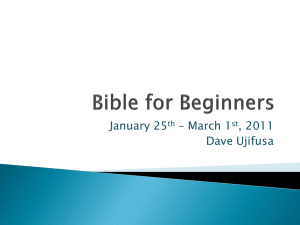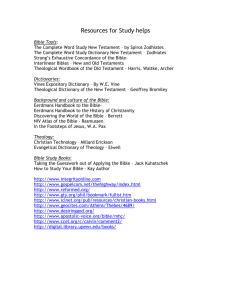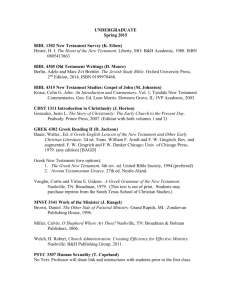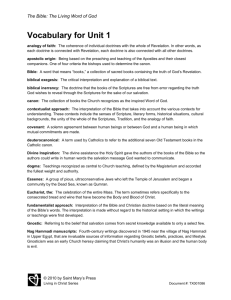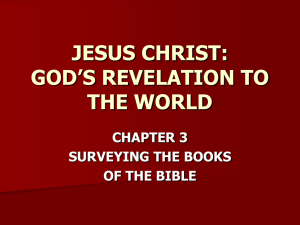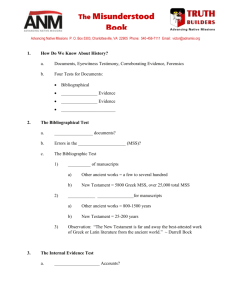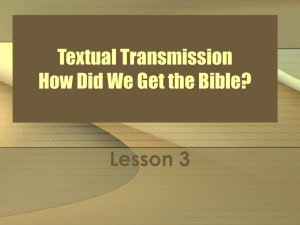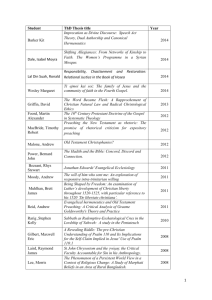Early Church – Bible and Canon – session 2 notes
advertisement
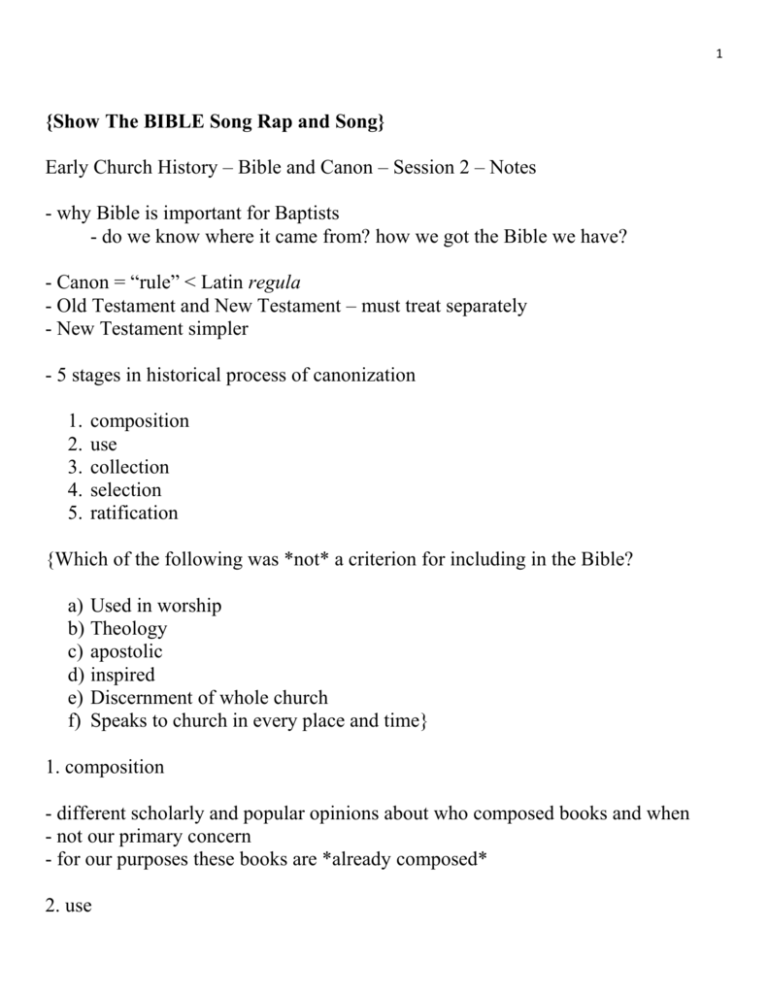
1
{Show The BIBLE Song Rap and Song}
Early Church History – Bible and Canon – Session 2 – Notes
- why Bible is important for Baptists
- do we know where it came from? how we got the Bible we have?
- Canon = “rule” < Latin regula
- Old Testament and New Testament – must treat separately
- New Testament simpler
- 5 stages in historical process of canonization
1.
2.
3.
4.
5.
composition
use
collection
selection
ratification
{Which of the following was *not* a criterion for including in the Bible?
a) Used in worship
b) Theology
c) apostolic
d) inspired
e) Discernment of whole church
f) Speaks to church in every place and time}
1. composition
- different scholarly and popular opinions about who composed books and when
- not our primary concern
- for our purposes these books are *already composed*
2. use
2
- extremely important – these books were read aloud publicly (= public worship)
3. collection
- very important
- books already exist
- local churches put together collections
- of books beyond what was written to them
- within 30 years – churches collect letters of Paul
- *letters of Paul = first collection*
- references to letters of Paul by 95, 115
- 2 Peter = “all Paul’s letters like other Scriptures” = 110?
- gospels more difficult
- early manuscripts
- references into (from?) mid 2nd c ~ 150 (and Acts right?)
- not references to a “New Testament” (no such things yet)
- same status and authority as Torah
- no references to writings not later in New Testament
- what principles do we discern?
1) importance of “apostles and prophets” – shape the worshiping community
2) communion with other churches
3) universal relevance – these speak to all Christians everywhere for all time
4. selection
- some “rejected” books later but some earlier than books in New Testament
- so date not only issue
- not all churches agreed on every choice
- differences
- Western church hardly touched James until 4th c
- but Eastern church early as Origen (early 3rd c)
- Shepherd of Hermas popular in West
- Apocalypse of Peter popular in East
- Hebrews popular in East
3
- no western writer until 368
- concerns about Revelation
- mainly because of Montanist controversy – not book itself!
- by 200 major Christian centers and writers using pretty much same canon we have
- evidence?
- Marcion 140
- Old Testament (mean God) versus New Testament (God of love)
- Law versus Gospel
- two different Gods!
- his Bible = 10 letters of Paul + edited Luke (by Paul)
- other stuff too “Jewish”
{tell story of listening to NPR and LSU professor on way to Prayer Breakfast?}
- Muratonian fragment (185?)
- 22/27 books of current New Testament
- lists others but does not reject
- useful for personal not public use
- does reject some!
- Diatessaron of Tatian 170
- four gospels -> one unified harmonious gospel
- “unofficial” canon!
- *summary* =
- all books we have in New Testament now
- excluding those *rejected*
- a few others sometimes accepted = “maybe” – but not rejected
- some differences (depending) on James, Jude, 2 Peter, Hebrews, 2-3 John,
Revelation
5. ratification
- “if orthodoxy was to survive – or Christian identity avoid being fragmented –
limits needed”
4
- Eusebius b Caesarea 4th c – 22 + 5 “disputed” = 27
- some works not canonical
- some works rejected
- firm but flexible canon – uncertain about Revelation
- *use in church + apostolic + theological consistency*
- Athanasius b Alexandria 367 – Easter letter
- 27
- others useful for instruction
- others rejected
- Council of Hippo 393
- Council of Carthage 397
- canon 39 – “to be read in the church as divine Scripture”
- first *bishops* then *entire church of bishops* agree “these – and no others”
*save discussion of criteria for later*
II. Old Testament
- a tale of two or more Old Testaments
- go back to before Jewish Diaspora
- *this is a gross oversimplification! not all scholars agree with this schema!*
- scholars *think* something like two main “versions” of Old Testament (ca 5th c
BC) =
1. Babylonian
2. Palestinian
- then later Palestinian -> Egypt (ca 4th c BC)
3. Egyptian
5
1) Babylonian -> “proto-Masoretic Text” -> Masoretic Text = standard Hebrew
Bible today (used as basis of Old Testament in Protestant Bibles)
2) Palestinian -> Samaritan Pentateuch
3) Egyptian -> Greek Septuagint ~ 150 BC = the standard Bible of the early
Christian church!
{Take a few minutes for Excursus on my pro-Jewish and pro-Hebrew
Bible/Masoretic Text bias}
- *the Bible of the early church was the Greek Bible!*
- had extra books
- some in Hebrew then translated into Greek
- some written only in Greek – never in Hebrew
- Christians used the Greek Old Testament to support Christian claims
- after destruction of Temple and Jerusalem
- Jewish leaders concerned about preserving Judaism
- and shutting down Christian use of (Greek) Old Testament to support
Christian claims about Jesus
- Council of Jamnia ~ 95? 135?
- *only the Hebrew Bible – “Babylonian” type*
- 39 books – so no Sirach, 1-2 Maccabees, different versions of Jeremiah,
Esther, Daniel
- *here is what most Protestant Christians do not know*
- the “longer” (Greek) Old Testament was the Bible of the Christian church until
Reformation
- Protestant Reformers (= Martin Luther) chose to accept Jewish version of Old
Testament
- other books rejected – “spurious” according to rabbis
- and went with Hebrew Bible (= Masoretic Text) rather than Greek Old
Testament
- and yet we still order books according to Greek Old Testament!
- (did not have time to explore this further – exactly who decided this? why?)
6
- this is why Catholic and Orthodox Bibles a little different
- Catholic and Orthodox almost the same
- “their” Old Testament is earlier? maybe? (lingering text critical issues)
- early church writers used “apocrypha” - sometimes
III. Criteria
- (mainly New Testament – Old Testament mostly a “given”)
- used in public worship – not private!
- came from or associated with apostles
- “inspiration” was not criterion – surely assumed but so were other writings
- speak to whole church in every place and time
- theological consistency – with “apostolic faith” = “orthodox”
- “sense of the church” (idea/phrase by Luke Timothy Johnson)
- best sense of what it is and called to be
- a few important observations =
- canon is pluralistic – not one single correct theology
- no canon within canon!
- plurality of witnesses
- Keith Putt – you can be consistent/coherent or comprehensive but not both
- church chose to be comprehensive and semi-coherent
{If time permits}
IV. Interpretation
- Eastern church – allegorical
- things mean other than what they are/say
- Western church – more typological
- things mean what they are/say – but also something else/more that is
similar/close


